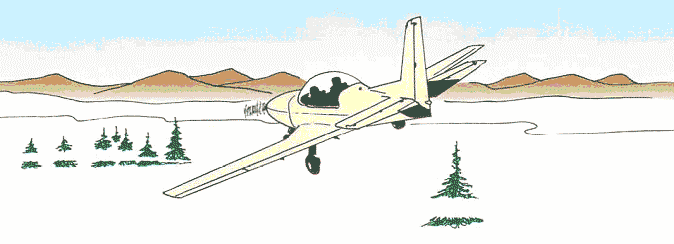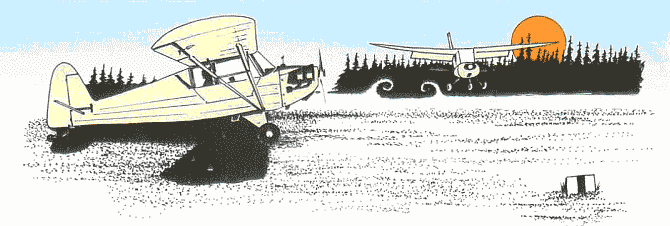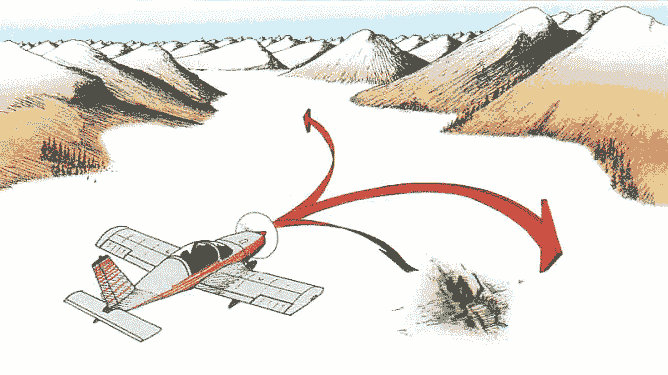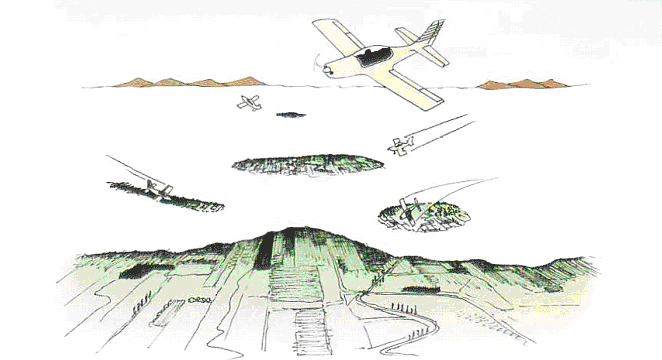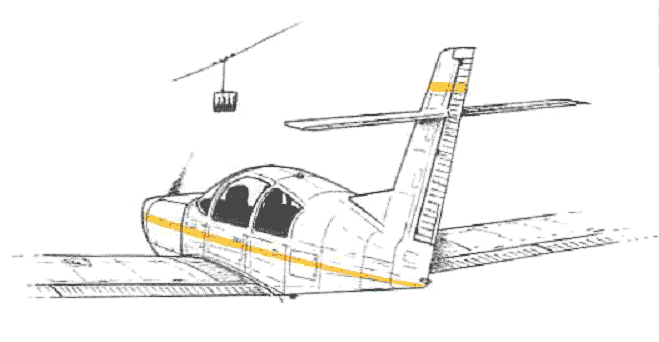

Aviation Hazard of Fog
There is probably fog in pilot's hell. No other weather phenomenon, apart from maybe strong turbulence, is as well suited to make the VFR pilot to break into cold sweat as are those little droplets of condensed moisture in the air. The situation of finding yourself in a soup of milky air around you, however, is almost always self inflicted. Either you have started prematurely without the proper awareness of risk, right into the grey mess or you were surprised by ground fog in flight and you have missed your opportunity to land safely in time. Shall I or shall I not? Most pilots encounter ground fog the first time on a clear autumn morning with little wind. Most of these mornings it is 'no go' on many of the lower lying airfields in rather moist areas such as river valleys. Pilots arriving at the airfield are surprised by the persistent grey soup that prevents a safe take off. While the sun was shining bright with not a single cloud spoiling the picture when they left home, the airfield is still sitting in dense grey fog that doesn't want to move.
Figure 1: Visibility in Fog - Blue skies but nothing goes. Every sensible pilot knows, that a comprehensive weather briefing is more important in autumn than in any other season. When the forecast indicates a trend to condensation near the ground, the pilot should seriously consider the option of postponing the flight. Depending on the atmospheric conditions and the temperatures en route, the spread can considerably reduce, resulting in fog. To recap: the spread is the difference between temperature and dew point, the latter being the point at which saturation is reached and condensation becomes highly likely. That might even happen, when the briefing has indicated no problems, as fog prediction is one of the more difficult tasks in meteorology. Even local circuit flying under these conditions has its dangers: Some pilots felt a false sense of security churning their circuits on the local airfield with the landing strip in sight, when the formation of fog was progressing faster than first thought and within minutes there was only a grey soup where the runway was before. One to be aware of is the case of fog being negligible and hardly visible from the birds perspective, which on final approach turns out to be so dense that no visual reference to the ground or the exact location of the runway is possible. Fog is more common in the colder seasons and less in summer. Often the sun manages only around noon to burn off the fog patches in autumn and winter. The effect is more or less pronounced depending on the region. Whereas in alpine regions autumn often presents sunny blue sky, an airfield only a few dozen miles away can sit in persistent fog due to its close vicinity of water, such as a large river. Being full of enthusiasm to fly, sitting around in such weather can be very frustrating. Pilots walking up and down the apron looking for the first blue patch of sky - "When is it opening up?" Often the bank of fog is just 200 or 300 ft thick. It requires a lot of will power to remain responsible and sensible. Under no circumstances one should try to start through the first small hole into the blue sky. - no matter how thin the layer of fog or how good a visibility is forecasted at the destination. One should roll to take-off only when fog has dissipated in the wider area and when a take-off is possible without risk. "Without risk" has only one sensible definition under these circumstances: A problem shortly after take-off or even an engine failure must not have fatal consequences. It is well possible after a safe start to fly over far stretching banks of fog. It is no problem to fly in 6000 ft over shallow banks of fog with large holes. Risk becomes calculable in safe altitude, when lots of ground is visible that could be reached in case of an emergency. In low altitude, however, ground visibility should never be lost. The risk to get into an unrecoverable attitude is just too high. Should the holes in cloud cover or fog become smaller only steep turns will prevent flying into cloud during descent. But slow descent in steep turns with flaps set can be trained. Worst case - certain accident The risk of engine failure after take off and in fog is minimal with a well serviced aircraft and after a few seconds ascent one should be on top of shallow ground fog. Even a beginner could be expected to remain straight and level for three or four seconds ascending through the soup. And if the pilot is trained to properly navigate he could follow his course with the help of modern GPS without bigger problems. But think again. Should the engine fail during ascent through a small hole or even through the soup, the destiny within the next few seconds becomes fairly predictable. Engine failure near the ground with a short gliding run through the fog ends in almost all cases in a deadly accident, as the pilot has no chance to avoid obstacles, pick an emergency landing spot, level the airplane off or touch down in a controlled manner with minimum speed.
Figure 2: How low can you go? More likely case - still a horror trip It has happened before: Pilot starts through the first hole and has to turn round for any reason. The fog has shifted just a few yards and minutes after take-off the airfield has turned IMC again. It doesn't take a fire, an engine failure or a bird hitting the windscreen, a forgotten petrol cap, an improperly closed baggage door flapping in the wind are enough to strike panic into any pilots heart. The sinking feeling that one should land immediately paired with the dawning understanding that a VFR airfield is nowhere near, is definitely one of the experiences that are suited to traumatise any pilot and spoil the fun of flying for a long time, should he come out alive that is. What is the point to roll for take-off on the first sight of holes in the fog, if seconds later your only wish is that you would have stayed on the ground? Who cares if it was legal to start under such conditions, if you realise after take-off, that you underestimated the situation and best climb will lead you straight into the wall of fog loosing sight of the ground and everything around you. Only IFR pilots or very experienced VFR pilots are able to stay cool in such moments. Would it not be better to avoid such situations from the outset?
Figure 3: No go fog Without experience under no visibility conditions, it is barely possible to do the right thing and come out of it unharmed. The right thing - climb with safe speed in a shallow ascent without turning on top of the bank of fog - is something that costs a lot of concentration for any VFR pilot. For somebody who never trained flying with the help of the artificial horizon, it doesn't help much to have the attitude indicator on board - he is in a life threatening situation. A small shift, a little acceleration in the inner ear are enough to set off vertigo, which will lead to total loss of control of the inexperienced pilot within seconds. A recovery in IMC? - forget it. Only professionals can pull that off if they have sufficient altitude. And that is what you don't have after an illegal low visibility take-off. Even if the take-off through the fog is successful and sunshine is greeting you after a few seconds, one thing is clear: You've got to come down sometime. The first glance will go to the fuel indicator. What to do if it happens despite all precautions So what do you do, if you find yourself in the uncomfortable situation on top of a layer of fog covering the airfield realising that you cannot land home?
Figure 4: Fog: decisions to make You should be clear about the answers to the following questions: Can alternative airfields be reached? If not, a safety landing should be performed as long as the ground is visible at all. Once spotted, holes in the fog should be used for safe descent carefully watching speed and avoiding a dip into the fog. Don't forget the carburetor heat: moist and cold air are ideal conditions for carburetor ice.
Figure 5: Fog descent - avoid flying into the fog. Don't waste time In any case, don't hesitate to long, if you got enough fuel try to reach an alternative airfield free of fog. Don't loose time, and contact FIS straight away to find out which direction to take. By the way, fog on the ground and panic rising, do not mean, one can fly through restricted airspace or even control zones as one wishes. He who has a good moving map GPS on board and knows how to use it, has a clear advantage. Identify an airfield free of fog, type in the designation, go into moving map mode to get an overview of the airspace borders around you, pick the shortest route possible and land. Simple? If it is late afternoon, the situation will worsen with the setting sun. Thin, hardly visible fields of fog will thicken with reducing spread, as the energy supply from the sun diminishes. Additional fog is the result. What is a great view from any airliner (that can be landed automatically if needed) - a horror trip for any private pilot with 50 solo hours on the clock. Falling temperatures can lead to fog freezing on the windscreen. When that happens, the controlled part of the flight is over for the VFR pilot. Only way out: immediate contact with FIS, get a radar fix and instructions to the next airport, which of course only those pilots will manage, who can fly straight and level to the artificial horizon, know the FIS or radar frequency by heart and don't have to get it from the map that's in the briefcase somewhere on the back seat. It is always a good idea to note the FIS frequency on the knee board. Such little details can be a life saver. Another possibility is to call for help on the emergency frequency: There have been cases, when a pilot trapped "on top" was led by an IFR equipped aircraft to a controlled airport for a safe landing. However, such a risky manoeuvre demand skills in formation flying and taking care of the dangerous vortex from the wing tip of the leading aircraft. Generally not a common exercise and not one to recommend. In the mountains or near slopes, there is sometimes another option to safety: Often the hill tops are free from fog. If the slope is not too steep and the alternatives for an emergency landing are running out, something that can be a good chance to go for. Better anyway than trying blind dipping through a badly defined layer of fog as a VFR pilot. In any case, before the safety or emergency landing, one should always call the emergency frequency or the next airport, so that emergency teams can be dispatched. Know your VORs in the vicinity so that you keep an idea of your position (not everybody owns a GPS). The VOR is no ILS, but a proper radial can lead you into the vicinity of the chosen airport and with a bit of luck, you'll have ground visibility there to do a proper VFR landing. However, to intercept and track a radial from an unknown position you would to have to had paid attention in navigation ground school and have practiced the skill a few times before:
What worked well in training is a different matter in real life. Under stress it will show, how much ingrained the skill really was. Keep it simple Therefore, in most cases it might be the better approach to call the controller, confess your mistake and ask for help. The radar controller not only can determine your position in an instant, but find out quickly where VMC are still present and lead you there by clear directions. The pilot can meanwhile fly the aircraft - staying level is enough a task for a VFR pilot under IMC. In extreme cases the controller could even try to direct the lost pilot on a landing course via QDM. This of course is only viable, when cloud ceiling over the airfield is low enough to attempt a VFR landing. A stabilised decent one or two minutes on a straight heading through the clouds is something that an amateur pilot might just about manage. Don't overestimate your skills If you are IFR equipped, got an artificial horizon and perhaps a moving map GPS and you have been trained to fly without visual reference you might think you've got a chance to reach the runway. Beware: controlling the aircraft, navigate, talk to the controller, change configuration, and maintain a safe glide path all without visual reference is far too much for the common VFR pilot, even hard work for an IFR pilot. To train for this situation as VFR pilot is ambiguous. A VFR pilot will always gain additional safety margin learning IFR basic techniques, of course. The problem: knowing only a little about flying without visual reference might give you a false sense of safety. To have learned the 180 degree turn with instruments does not necessarily give you the skills to manage a longer flight without visuals. Persistent training on the basics of instrument flight is the only thing that prepares you for the emergency.
Figure 6: That's too low. Never should the VFR pilot use the learned skills to fly into clouds on purpose. Stay responsible and don't risk a manoeuvre that is uncalculable and still very dangerous. When there is sufficient fuel on board and plenty of time till sunset, a longer flight to a VFR airfield is probably the best option. Return from Aviation hazard of fog page to Aviation Weather page |









